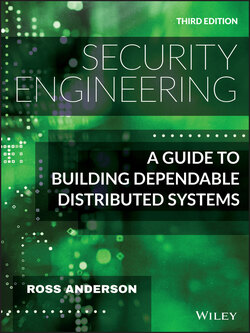Читать книгу Security Engineering - Ross Anderson - Страница 138
4.8 Design assurance
ОглавлениеSubtle difficulties of the kind we have seen above, and the many ways in which protection properties depend on subtle assumptions that may be misunderstood, have led researchers to apply formal methods to protocols. The goal of this exercise was originally to decide whether a protocol was right or wrong: it should either be proved correct, or an attack should be exhibited. We often find that the process helps clarify the assumptions that underlie a given protocol.
There are several different approaches to verifying the correctness of protocols. One of the best known is the logic of belief, or BAN logic, named after its inventors Burrows, Abadi and Needham [352]. It reasons about what a principal might reasonably believe having seen certain messages, timestamps and so on. Other researchers have applied mainstream formal methods such as CSP and verification tools such as Isabelle.
Some history exists of flaws being found in protocols that had been proved correct using formal methods; I described an example in Chapter 3 of the second edition, of how the BAN logic was used to verify a bank card used for stored-value payments. That's still used in Germany as the ‘Geldkarte’ but elsewhere its use has died out (it was Net1 in South Africa, Proton in Belgium, Moneo in France and a VISA product called COPAC). I've therefore decided to drop the gory details from this edition; the second edition is free online, so you can download and read the details.
Formal methods can be an excellent way of finding bugs in security protocol designs as they force the designer to make everything explicit and thus confront difficult design choices that might otherwise be fudged. But they have their limitations, too.
We often find bugs in verified protocols; they're just not in the part that we verified. For example, Larry Paulson verified the SSL/TLS protocol using his Isabelle theorem prover in 1998, and about one security bug has been found every year since then. These have not been flaws in the basic design but exploited additional features that had been added later, and implementation issues such as timing attacks, which we'll discuss later. In this case there was no failure of the formal method; that simply told the attackers where they needn't bother looking.
For these reasons, people have explored alternative ways of assuring the design of authentication protocols, including the idea of protocol robustness. Just as structured programming techniques aim to ensure that software is designed methodically and nothing of importance is left out, so robust protocol design is largely about explicitness. Robustness principles include that the interpretation of a protocol should depend only on its content, not its context; so everything of importance (such as principals' names) should be stated explicitly in the messages. It should not be possible to interpret data in more than one way; so the message formats need to make clear what's a name, what's an address, what's a timestamp, and so on; string formats have to be unambiguous and it should be impossible to use the protocol itself to mount attacks on the software that handles it, such as by buffer overflows. There are other issues concerning the freshness provided by counters, timestamps and random challenges, and on the way encryption is used. If the protocol uses public key cryptography or digital signature mechanisms, there are more subtle attacks and further robustness issues, which we'll start to tackle in the next chapter. To whet your appetite, randomness in protocol often helps robustness at other layers, since it makes it harder to do a whole range of attacks – from those based on mathematical cryptanalysis through those that exploit side-channels such as power consumption and timing to physical attacks that involve microprobes or lasers.
